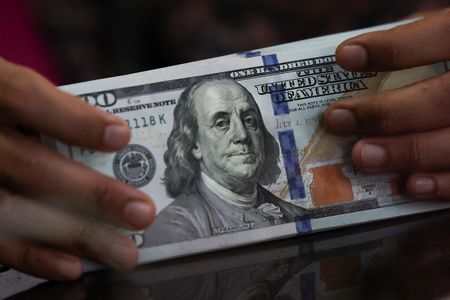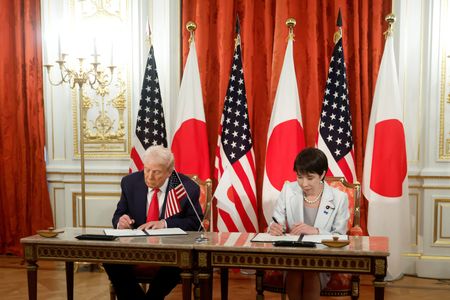By Ankur Banerjee and Lucy Raitano
SINGAPORE/LONDON (Reuters) -The dollar steadied on Tuesday ahead of an expected Federal Reserve rate cut, while the yen rose after the U.S. treasury secretary urged the Bank of Japan to follow “sound monetary policy”, which investors took as a call for higher rates.
The yen strengthened 0.48% to 151.15 per U.S. dollar ahead of a Bank of Japan meeting this week where the central bank is expected to hold rates steady, but the focus will be on whether it provides clues on the timing of the next hike.
Comments from Treasury Secretary Scott Bessent lifted the yen as he called for “sound monetary policy” during his meeting with Japanese counterpart Satsuki Katayama, in his latest swipe at the slow pace of interest rate hikes by the BOJ.
“Bessent is stating a clear preference for conventional policy tools like interest rate hikes rather than FX intervention, that took dollar/yen down,” said Kamal Sharma, senior FX strategist at Bank of America.
Investors were also weighing President Donald Trump’s meeting with Japan’s new Prime Minister Sanae Takaichi in Tokyo on Tuesday, where he welcomed her pledge to accelerate a military buildup and signed deals on trade and rare earths.
CHINA TRADE DEAL HOPES REMAIN INTACT
While early signs of easing trade tensions between the U.S. and China led to a risk rally on Monday, with the dollar slipping against rivals, investors are apprehensive that any real Sino-U.S. deal may offer far less to celebrate.
The spotlight will be on the meeting between Trump and Chinese President Xi Jinping in South Korea on Thursday. “I’ve got a lot of respect for President Xi and I think we’re going to come away with a deal,” Trump told reporters on Air Force One before landing in Tokyo.
Chinese officials have so far been circumspect about trade talks with U.S. counterparts and have said little on the potential outcome.
Vasu Menon, managing director of investment strategy at OCBC, said it was possible there might not be a “perfect resolution or even a resolution in some cases, and the can could be kicked down the road to be addressed later.”
“When you have two economic superpowers with strong-headed leaders trying to work out a deal, one can imagine that it will not be a seamless affair,” he said.
But Menon added that if the two leaders are able to make some concrete progress, it may be enough to satisfy markets for now as investors seek silver linings to keep the bull run on track.
The anticipation around the outcome of trade talks and an expected 25-basis-point rate cut from the Federal Reserve have left the dollar on the back foot. The euro hit a one-week high of $1.166 on Tuesday and was last flat.
Sterling meanwhile fell 0.3% to $1.3291, as traders refocused on the UK’s tricky fiscal backdrop ahead of a Bank of England (BoE) meeting due next week and a budget set for November.
The dollar index, which measures the U.S. currency against six other units, was unchanged at 98.81, having dropped 0.15% in the previous session.
“The market is continuing to struggle with themes, a lot of those dynamics at the beginning and to the middle of the year post-Liberation Day are well known now: politicisation of the Fed, FX hedging, de-dollarisation,” said BofA’s Sharma.
He said the team at BofA thinks the same themes will be at play over the course of the next year, leading to more dollar weakness.
FED MEETING IN FOCUS
With a rate cut from the Fed priced in, markets will closely watch for any signs that the central bank may be preparing to wind down its quantitative tightening program.
Focus will also be on whether the central bank and Fed Chair Jerome Powell provide clarity on further rate cuts as the U.S. government shutdown continues, leaving policymakers without economic data. Traders are pricing in another cut in December.
“We do not expect formal guidance about the December meeting, but if Chair Powell is asked, he will likely be comfortable referencing the September dots, which imply a third cut in December,” said David Mericle, chief U.S. economist at Goldman Sachs. The Fed cut rates last month by 25 bps.
Over in Europe, the European Central Bank is all but certain to keep rates on hold again on Thursday as traders waver on whether it will resume easing next year.
The Australian dollar, often seen as a proxy for risk appetite, was unchanged at $0.6556, a two-week high. The New Zealand dollar was also steady at $0.5768.
(Reporting by Ankur Banerjee in Singapore and Lucy Raitano in London; Editing by Muralikumar Anantharaman, Jamie Freed and Sharon Singleton)










